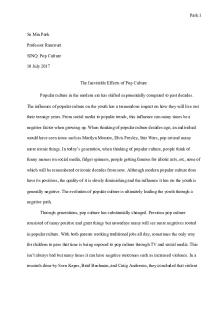CHAPTER II (The effect of Korean pop music in Filipino teenager to their culture and life style DOC

| Title | CHAPTER II (The effect of Korean pop music in Filipino teenager to their culture and life style |
|---|---|
| Author | Love Mercadal |
| Pages | 7 |
| File Size | 44 KB |
| File Type | DOC |
| Total Downloads | 36 |
| Total Views | 764 |
Summary
CHAPTER II (The effect of Korean pop music in Filipino teenager to their culture and life style) RELATED LITERATURE FOREIGN The Korean wave refers to the significantly increased popularity of South Korean culture around the world; it is also referred to as hallyu, in the Korean language. The term ...
Description
CHAPTER II (The effect of Korean pop music in Filipino teenager to their culture and life style) RELATED LITERATURE FOREIGN The Korean wave refers to the significantly increased popularity of South Korean culture around the world; it is also referred to as hallyu, in the Korean language. The term was coined in China in mid-1999 by Beijing journalists surprised by the fast growing popularity of Korean entertainment and culture in China (Kim, 2007, p. 15). Broadly speaking, it can be said that the popularity of Korean pop music and television soap operas in China and Taiwan sparked the Korean wave abroad. The outbreak of hallyu can be traced back to 1997, when the Korean TV drama, What Is Love All About, broadcast on state-run Chinese television, CCTV, set the stage for hallyu in China, following an MBC-TV drama, Jealous, which was imported as the first popular cultural product from South Korea in 1993 (Kim, 2007, p. 15). Since then, the boom of Korean popular culture in the neighboring Asian countries has remarkably increased and significantly penetrated them over the past several years, and in the years 2000 through 2002, according to one source, "the Korean wave moved forward to diverse parts of Asia, including Southeast and Central Asia, and therefore this wave reached an active penetration stage" (Hyejung, 2007, p. 6). Interestingly, though every country in Asia had a common reaction toward the Korean wave at first, each had a slightly different outlook. This is because "each country has a different ethos, and based on this, its audience decodes and responds to cultural products in different ways" (Kim, 2007, p. 24). For example, in Taiwan, Daejangguem had the best reception of any Korean drama, whereas in Japan, Korea Herald was most popular (Kim, 2007, p. 24). The trend soon spread out from the mainland to Taiwan, Hong Kong, affecting ethnic Chinese in other Asian countries and eventually Japan, leading all these Asian peoples to be fascinated by not only Korean music and drama, but also its films, food and fashion. Accordingly, Korean cultural products have become a catalyst for curiosity about Korean culture and Korea itself. Korean dramas in particular have served as an important bridge for...
Similar Free PDFs

GUPPIES AND THEIR LIFE STYLE
- 6 Pages

Pop Music in Culture Week 13
- 5 Pages

Greek Mythology in Pop Culture
- 3 Pages

Serial Killers in pop culture
- 4 Pages

Avant-garde in Pop Music Videos
- 10 Pages

Pop Culture - Notes
- 10 Pages
Popular Institutions
- Tinajero National High School - Annex
- Politeknik Caltex Riau
- Yokohama City University
- SGT University
- University of Al-Qadisiyah
- Divine Word College of Vigan
- Techniek College Rotterdam
- Universidade de Santiago
- Universiti Teknologi MARA Cawangan Johor Kampus Pasir Gudang
- Poltekkes Kemenkes Yogyakarta
- Baguio City National High School
- Colegio san marcos
- preparatoria uno
- Centro de Bachillerato Tecnológico Industrial y de Servicios No. 107
- Dalian Maritime University
- Quang Trung Secondary School
- Colegio Tecnológico en Informática
- Corporación Regional de Educación Superior
- Grupo CEDVA
- Dar Al Uloom University
- Centro de Estudios Preuniversitarios de la Universidad Nacional de Ingeniería
- 上智大学
- Aakash International School, Nuna Majara
- San Felipe Neri Catholic School
- Kang Chiao International School - New Taipei City
- Misamis Occidental National High School
- Institución Educativa Escuela Normal Juan Ladrilleros
- Kolehiyo ng Pantukan
- Batanes State College
- Instituto Continental
- Sekolah Menengah Kejuruan Kesehatan Kaltara (Tarakan)
- Colegio de La Inmaculada Concepcion - Cebu









